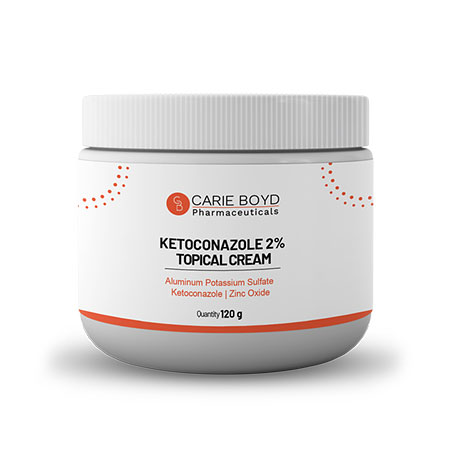Advanced Wound Care
Home » Advanced Wound Care » Ketoconazole Cream
Our products
Ketoconazole cream 2%
Office-Use Medication
Ketoconazole cream 2% in a 4 oz white jar, 120 g per jar. It contains Aluminum Potassium Sulfate, Ketoconazole (2.52g), and Zinc Oxide. Sold to qualified healthcare providers.
The cream protects from skin breakdown and pressure ulcers, which are common with bedridden, elderly, and immunocompromised patients in hospitals, nursing homes, and rehab facilities. Not for use in children under the age of 6.
- Size: 120g, 4oz jar
- Delivery: Topical Cream
- Preparation Type: Non-Sterile
- BUD: 180 days
- Storage: Room Temperature
- Distributed by our 503B outsourcing facility
For qualified providers, Carie Boyd Pharmaceuticals offers Ketoconazole cream 2% in a 4 oz white jar, 120 g per jar. Ketoconazole cream is formulated with zinc and ketoconazole in a petroleum base. Zinc oxide is widely used to treat a variety of skin conditions, including atopic dermatitis, contact dermatitis, itching due to eczema, diaper rash, and acne.
The cream is stored at room temperature (25 degrees Celsius) until meets beyond use date. Currently, we offer the cream with BUD 180 days.
- Ketoconazole 2.52g. Ketoconazole has a broad spectrum of antifungal activity, including many candida infections.
- Aluminum Potassium Sulfate. Aluminum Potassium Sulfate is used as an astringent or styptic for minor bleeding.
- Zinc Oxide. Zinc Oxide helps skin to stay dry and protects from skin chafing.
- White petrolatum and salt stable cream base. White petrolatum and salt stable cream provide additional protection from skin breakdown.
Ketoconazole Cream Advantages:
- A cream base acts as a barrier to skin becoming wet or irritated.
- It forms an oil layer to keep the skin hydrated.
It provides deep transdermal penetration of active ingredients into the wound bed to promote healing. - It helps to maintain the correct pH.
- Fragrance-free.
Ketoconazole cream is placed in a cream base with petrolatum ointment to prevent skin from becoming wet or irritated. Acting as an emollient, the cream base helps to protect the skin and form an oil layer to keep the skin hydrated. The salt durable cream helps to maintain the correct pH and stabilize the formulation. It is also fragrance-free to limit allergic or skin sensitivity reactions. This base also provides deep transdermal penetration, which aids in quicker healing the skin and treating potential fungal infections.
You can order Ketoconazole cream 2% on the website, or via email or fax.
Contact us today for additional information (817) 282-9376.
Not a client yet? Enroll with us today.
Literature Review:
Wound care is a major healthcare expenditure. Treatment of burns, surgical and trauma wounds, diabetic lower limb ulcers and skin wounds is a major medical challenge with current therapies largely focused on supportive care measures. Successful wound repair requires a series of tightly coordinated steps including coagulation, inflammation, angiogenesis, new tissue formation and extracellular matrix remodeling. Zinc is an essential trace element (micronutrient) which plays important roles in human physiology. Zinc is a cofactor for many metalloenzymes required for cell membrane repair, cell proliferation, growth and immune system function. The pathological effects of zinc deficiency include the occurrence of skin lesions, growth retardation, impaired immune function and compromised wound healing.” Zinc in Wound Healing Modulation, https://www.ncbi.nlm.nih.gov/pmc/articles/PMC5793244/
Zinc is an essential trace element in the human body and its importance in health and disease is appreciated. It serves as a cofactor in numerous transcription factors and enzyme systems including zinc-dependent matrix metalloproteinases that augment auto-debridement and keratinocyte migration during wound repair. Zinc confers resistance to epithelial apoptosis through cryoprotection against reactive oxygen species and bacterial toxins possibly through antioxidant activity of the cysteine-rich metallothionein. Zinc deficiency of hereditary or dietary causes can lead to pathological changes and delayed wound healing. Topical administration of zinc appears to be superior to oral therapy due to its action in reducing superinfections and necrotic material via enhanced local defense systems and collagenolytic activity, and the sustained release of zinc ions that stimulates epithelialization of wound. Zinc is transported through the skin from these formulations, although the systemic effects seem insignificant.” Zinc in wound healing: theoretical, experimental, and clinical aspects. https://pubmed.ncbi.nlm.nih.gov/17244314/
Zinc, both in elemental or in its salt forms, has been used as a therapeutic modality for centuries. Topical preparations like zinc oxide, calamine, or zinc pyrithione have been in use as photoprotecting, soothing agents or as active ingredient of antidandruff shampoos. Its use has expanded manifold over the years for a number of dermatological conditions including infections (leishmaniasis, warts), inflammatory dermatoses (acne vulgaris, rosacea), pigmentary disorders (melasma), and neoplasias (basal cell carcinoma). Although the role of oral zinc is well-established in human zinc deficiency syndromes including acrodermatitis enteropathica, it is only in recent years that importance of zinc as a micronutrient essential for infant growth and development has been recognized. The paper reviews various dermatological uses of zinc.” Zinc Therapy in Dermatology: A Review. https://www.ncbi.nlm.nih.gov/pmc/articles/PMC4120804/
Call us (817) 282-9376 to learn more

